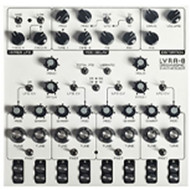SOMA Laboratory - Lyra 8
by Kyle Swisher
Hailing from Russia and built like your babushka’s favorite samovar, the SOMA Lyra 8 Organismic Synthesizer is a touch sensitive polyphonic synthesizer triggered by the user's body capacitance via the round metal sensors located at the bottom. With 8 variable wave shape oscillators, 4 envelopes, 2 LFOs, a bunch of frequency modulation options, built in vibrato, 2 delays, and distortion all being controlled by a menagerie of knobs and switches, this synth’s visual style hearkens back to the days of early Moog and EMS, and is like something out of a synth-nerd Twilight Zone.
One thing that sets the tone [literally] right off the bat and that SOMA points out early in their manual is that their oscillators are not VCOs, and that "instead of having a linear or logarithmic dependency on control voltage, they resemble the tone generators in old electric organs." Indeed, the timbres of the 8 voices that the Lyra 8 produces do not sound like your typical triangle or square waveforms. The notes are enveloped by a haunting mist and in some mid-range frequencies, have a spitty woodwind quality. These non-VCO oscillator's wave shapes are controlled by a "SHARP" knob that determines the shape of the paired voices–from triangle [counterclockwise] to square [clockwise]–effectively changing the voice's tone from soft and dull to bright and "SHARP”. Voices are paired up as 1+2, 3+4, 5+6, an 7+8, with each pair sharing an envelope, a modulation knob that sets the depth of the LFO, external CV, Total Feedback [we'll get to that later], and Frequency Modulation [if engaged by the modulation switch]. The paired voices are then grouped 1-4 and 5-8 and are governed by an overall pitch knob that can transpose the group. Take this with a grain of salt as you'll need to have this knob turned nearly all the way up to preserve the tuning stability of the grouped voices, and twisting the knob while the voices are active sounds like changing the speed of a record player mid song.
Each group has an optional "HOLD" knob that can send the voices into a continuous drone, with "HOLD" taking its cue from the envelope settings, selectable via a toggle switch. In the unlabeled up position, you'll get a slow decay lasting around 30 seconds, while in the down “FAST” position, the decay is a short 0.5 seconds. If the envelope is slow the paired voices will start to drone when "HOLD" is set to 12 o'clock. When the envelope is "FAST" the voices won't drone until the knob is set to 2 o'clock or higher. While the range between settings is vast, in the context of the instrument it feels appropriate, and varying the envelope settings between the voice pairs can allow the user to manually play one pair of voices while the other pair can drone on without being touched.
The "VIBRATO" switch turns the effect on for all voices, but each voice has an individually varied rate of speed and depth. I adore this feature because it brings a human affect to the fold and feels like a string octet with its members varying in talent, causing a symphony of rippling waves to beautifully clash. Turning on the "TOTAL FB" [feedback] feature replaces LFO or external CV modulation with a feedback loop by routing the Lyra's output signal back into the voice. I refer to this as the "Apocalypse" setting as it will sonically destroy everything in its path.
My vote for the most charmingly convoluted section of the Lyra 8 is the "HYPER LFO" corner. It consists of two square wave LFOs, each with their own frequency knob, which determines their LFO rate, labeled as "FREQ A" and "FREQ B." Both LFOs are tied together and will in tandem effect the signal they’re modulating. The "AND / OR" switch will add FREQ A to FREQ B when in the down position, or will multiply FREQ A by FREQ B when in the up position. The link switch adds a soft FM between the two LFOs. All of this peculiarity provides interesting rhythms when they are heavily modulating a set of voices, and this section impressed me most when I twisted and switched aimlessly, eventually falling upon a rhythm that I wasn't expecting.
The feature that puts this machine over he top for me is the MOD DELAY section. Two delay times share a feedback and mix knob, and can either be modulated by its own delay time, as in "SELF" mode, or by the LFO in square or dual triangle mode. I've spent hours with the feedback turned up to get the delays into self oscillation while experimenting with different modulation settings, and though the delays do get pretty noisy when set to longer delay times, the Lyra's M.O. is just that; Noisy. Speaking of noisy, the signal path comes to an end in the distortion section with a "DRIVE" knob that controls the amount of distortion, and a "MIX" knob that blends the clean signal with the distortion.
With its many voices, "HOLD" function, and modulation options, the Lyra 8 is a drone king. It can sound majestic and soaring, while constantly teetering on the edge of chaos– as if it's dying to become the main focus of your electronic doom metal band. Similar to a modular system, some settings are almost impossible to recreate, and because of this I've become a bit of a documentarian with the Lyra 8. Once I land on an inspiring setting I'll commit it to tape because there's a good chance I'll never hear those fowl squawks, whale moans, or snarling Baphomet sounds ever again. Confident in it's choices, SOMA's Lyra 8 Organismic Synthesizer is a fascinating specimen, one that I’ve lost many hours to.
Price: $839.99


